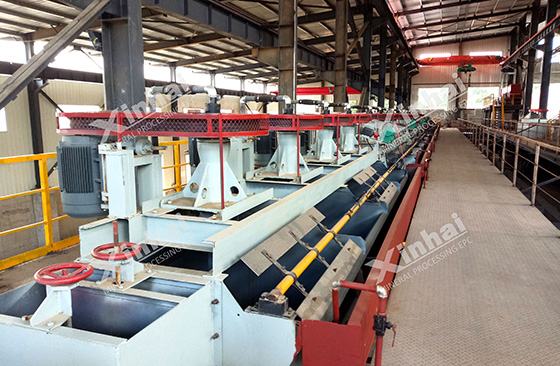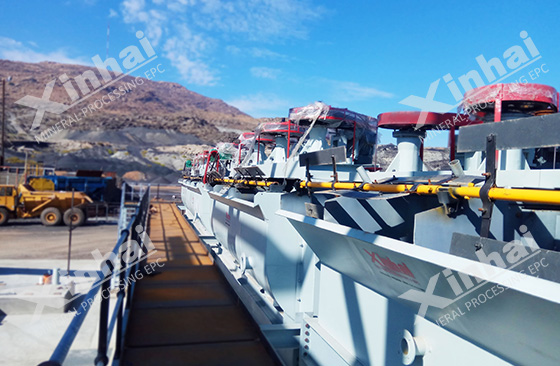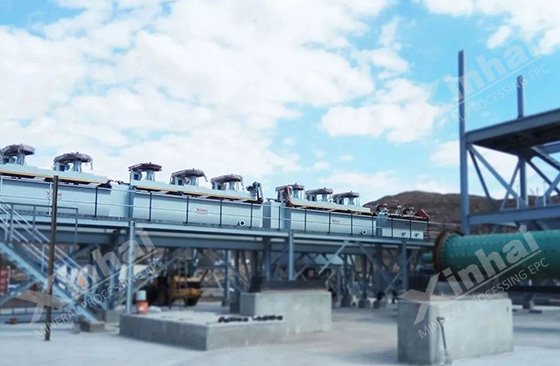
Chalcopyrite and pyrrhotite are both sulfide minerals, and they often coexist and are associated with some copper ores. As the main source of copper, chalcopyrite generally requires mineral processing technology to separate chalcopyrite and pyrrhotite. The commonly used technology is flotation separation technology. Depending on the properties of the ore, the concentrator generally chooses different flotation processes. The following will introduce you to the four flotation processes of chalcopyrite and pyrrhotite, namely: priority flotation process, mixed flotation process, equal flotation process and new flotation process.

(flotation separation process)
It can be divided into full priority flotation separation process and partial priority flotation separation process. According to the difference in floatability of chalcopyrite and pyrrhotite in the ore, chalcopyrite and pyrrhotite are floated out from the slurry in turn. When gold and silver are associated with copper sulfide ores, the associated gold and silver are usually present in copper ore physics, so the enrichment of gold and silver is often recovered together with the copper in copper sulfide. Since the preferential flotation process is based on the difference in floatability between sulfide ores, copper sulfide ores with good floatability will be recovered preferentially. This process is suitable for processing ores with simple ore properties and large differences in floatability between useful minerals and gangue minerals.

(Copper ore flotation separation process)
This process requires the use of a mixed flotation collector to float out copper and sulfur minerals at the same time to obtain copper-sulfur mixed concentrate and tailings. Then add sulfur inhibitors to the mixed concentrate slurry and separate copper and sulfur to obtain qualified copper concentrate and sulfur concentrate. If the degree of monomer dissociation of the mixed concentrate is poor, it needs to be included in the regrinding process to ensure that the minerals are fully dissociated before copper and sulfur are separated. Depending on the chalcophilicity or affinity of associated gold and silver, it is determined which concentrate the gold and silver is concentrated in. For cuprophilic associated gold and silver, they are generally chosen to be enriched in copper concentrates. The affinity associated gold and silver are concentrated in sulfur concentrates. This process is mainly used to process ores with low copper grade and relatively simple properties, which can reduce grinding costs.

(flotation separation process)
Due to the similar floatability of sulfide minerals, it is difficult to separate these minerals using the traditional mixed flotation process. Especially when the content of pyrrhotite is large, a large amount of inhibitors are required for treatment, and preferential flotation is used. Process flow can solve this problem. However, when the pyrrhotite content is high, it is more difficult to inhibit sulfur flotation from copper, and it is difficult to activate sulfur minerals after being inhibited. Therefore, the flotation process of copper and sulfur is selected at this time. This process can mix and float copper and part of the sulfur and then separate them separately. The mixed flotation tailings can be flotated to recover the sulfur minerals in the tailings.

In addition to the three common flotation processes mentioned above, for copper-sulfur deposits with different ore properties, you can choose from step flotation, flash flotation, asynchronous mixed flotation, priority-mixed step flotation, and staged grinding stages. Sorting, separation and smelting combined and maglev combined process flow. When the secondary copper sulfide content of copper tailings is high and some copper minerals have a close symbiotic relationship with pyrite, rapid flotation of copper minerals can be used to improve the copper ore flotation index, and then the copper-sulfur mixed flotation and separation process can be used , which can improve the recovery rate of copper and sulfur.

The above are four flotation separation processes for chalcopyrite and pyrrhotite. Since different copper ores have different flotation processes, the specific mineral processing process should be selected based on the characteristics of the copper ore. Xinhai Mining recommends conducting mineral processing tests and selecting and optimizing the copper ore flotation process based on the test results to achieve the purpose of improving the quality and recovery rate of copper concentrate. Xinhai Mining can provide you with the entire copper industry chain service (EPC+M+O), from ore composition analysis, mineral processing process design, complete equipment production and manufacturing, equipment installation and commissioning to mine operation management, tailor-made for you copper ore concentrator.
To find out more about our products and solutions, please fill out the form below and one of our experts will get back to you shortly.